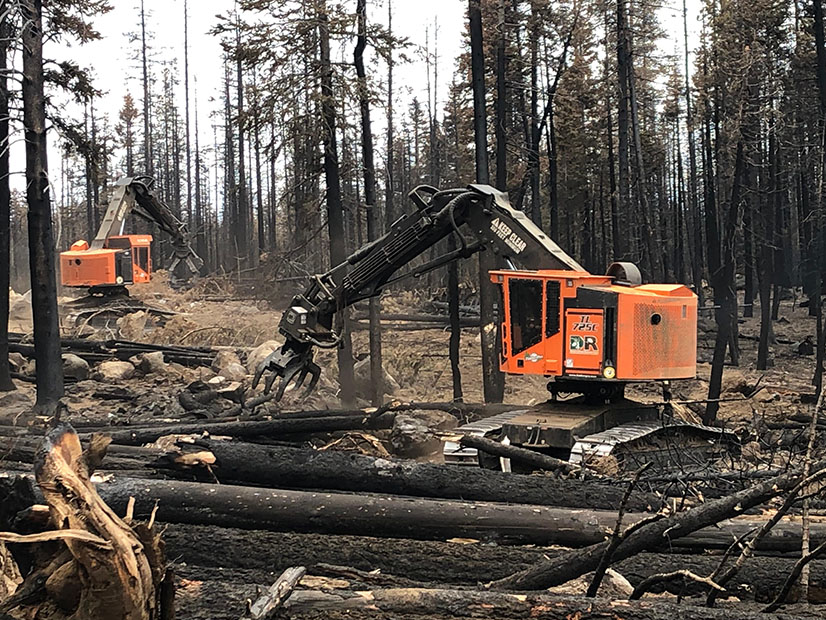Pacific Gas and Electric (NYSE:PCG) said Monday it expects to incur $1.15 billion in costs from the nearly 1 million-acre Dixie Fire this summer and disclosed for the first time that federal prosecutors subpoenaed records related to the fire, the second-largest wildland blaze in state history.
The disclosures were part of PG&E’s third-quarter filing with the U.S. Securities and Exchange Commission, in which PG&E reported a nearly $1.1 billion loss (-$0.55/share) in the third quarter because of wildfire costs and expenses related to its Chapter 11 bankruptcy reorganization that concluded last year. The company earned $83 million ($0.04/share) a year earlier.
The news pushed PG&E’s already depressed stock price from a high of $11.59/share at 9:30 a.m. to a low of $11.20/share before it recovered to $11.41/share by close of trading Monday. (See PG&E Value Lags as Dixie Fire Rages.)
PG&E, however, said it expects to recover much of the $1.15 billion Dixie Fire loss from its insurance, ratepayers and the state’s wildfire recovery fund created under Assembly Bill 1054 in 2019.
In an earnings call Monday, CEO Patti Poppe expressed optimism that the state’s largest utility is on track to overcome its record of starting devastating wildfires in the past six years by improving its safety practices.
“Every day we are more and more excited about the future we’re creating here at PG&E,” Poppe said. “We can see the difference that’s being made and the value to be unlocked.”
She cited the utility’s “very sophisticated and continually improving PSPS algorithm,” which predicts conditions that warrant de-energizing lines in public safety power shutoffs.
“In fact, when we back-cast our current models to the previous utility-caused fires between 2012 and 2020, we would have prevented 96% of the structure damage had the current model been in place,” Poppe said.
“This year, we also implemented enhanced power line safety settings to address wildfire risks we face from extreme drought conditions,” she said. “In fact, since the end of July through mid-October, we saw a 46% decrease in CPUC-reportable ignitions in high-fire threat districts and an 80% reduction in ignitions on enabled circuits. These enhanced safety settings make our system and our customers safer.”
The enhanced powerline safety settings have caused controversy since PG&E started using its “fast-trip” wildfire prevention devices in late July, cutting power to customers without notice.
California Public Utilities Commission President Marybel Batjer wrote to Poppe on Oct. 25 demanding changes.
“Pacific Gas and Electric Company’s execution and communication of its wildfire mitigation device setting known as Fast Trip has been extremely concerning and requires immediate action to better support customers in the event of an outage,” Batjer wrote. “Since PG&E initiated the fast-trip setting practice on 11,500 miles of lines … it has caused over 500 unplanned power outages impacting over 560,000 customers. These Fast Trip-caused outages occur with no notice and can last hours or days.”
“Though PG&E reports that implementation of fast-trip settings has significantly reduced reportable wildfire ignitions from contact with its power lines, this approach has also significantly increased the frequency and duration of unplanned power outages for its customers, causing confusion and frustration in communities constantly vigilant of wildfire threats.”
Dixie Fire
The cause of the 963,000-acre Dixie Fire remains under investigation by the California Department of Forestry and Fire Protection, which seized PG&E equipment from the presumed ignition point in the Northern California’s rugged Feather River Canyon in July.
In addition, the “Butte County, Plumas County, Shasta County, Lassen County and Tehama County District Attorneys’ Offices are investigating the fire; various other entities, which may include other state and federal law enforcement agencies, may also be investigating the fire,” PG&E said its SEC filing.
“On October 7, 2021, the United States Attorney’s Office for the Eastern District of California served PG&E Corp. and [its utility subsidiary, Pacific Gas and Electric] with a subpoena for the production of documents,” it said. “It is uncertain when any such investigations will be complete.”
PG&E acknowledged in July that a tree falling on one its lines may have started the Dixie Fire northeast of Paradise, a town destroyed by the PG&E-caused Camp Fire in November 2018. (See PG&E Says Its Line May Have Started Dixie Fire.)
On July 13 at 7 a.m., “PG&E’s outage system indicated that Cresta Dam off of Highway 70 in the Feather River Canyon lost power,” the utility said in an incident report filed with the CPUC. “The responding PG&E troubleman observed from a distance what he thought was a blown fuse [on a 12-kV distribution line uphill from him].”
The PG&E worker could not reach the pole until later that afternoon because of a road closure and rugged terrain, PG&E said. Once there, he found two blown fuses and “what appeared to him to be a healthy green tree leaning into the Bucks Creek 1101 12-kV conductor, which was still intact and suspended on the poles. He also observed a fire on the ground near the base of the tree,” PG&E told the CPUC.
The fire destroyed 1,329 structures and killed one person, according to Cal Fire. It burned for more than three months through the Plumas National Forest, Lassen National Forest, Lassen Volcanic National Park, and across five counties before it was declared 100% contained on Oct. 24.


